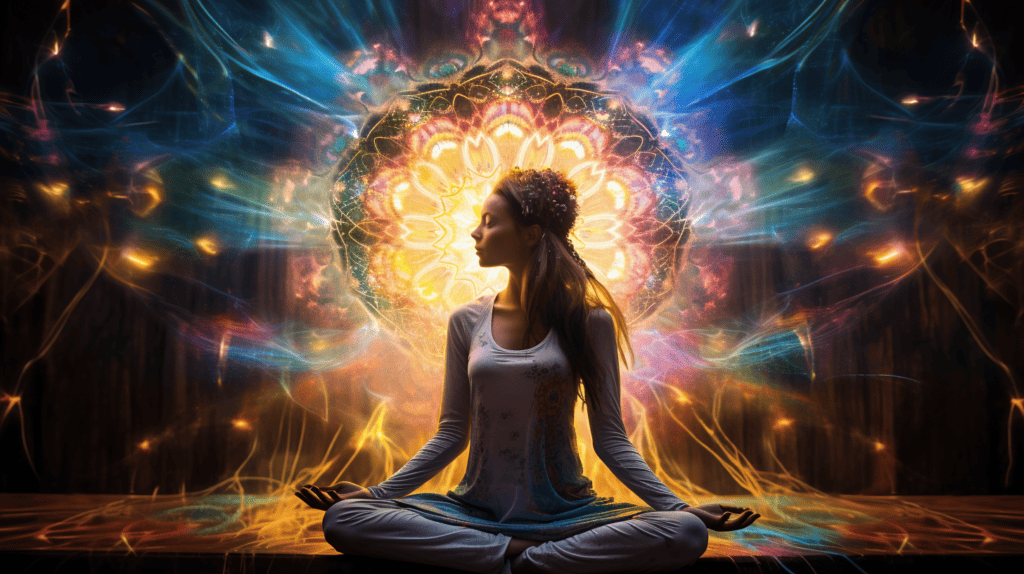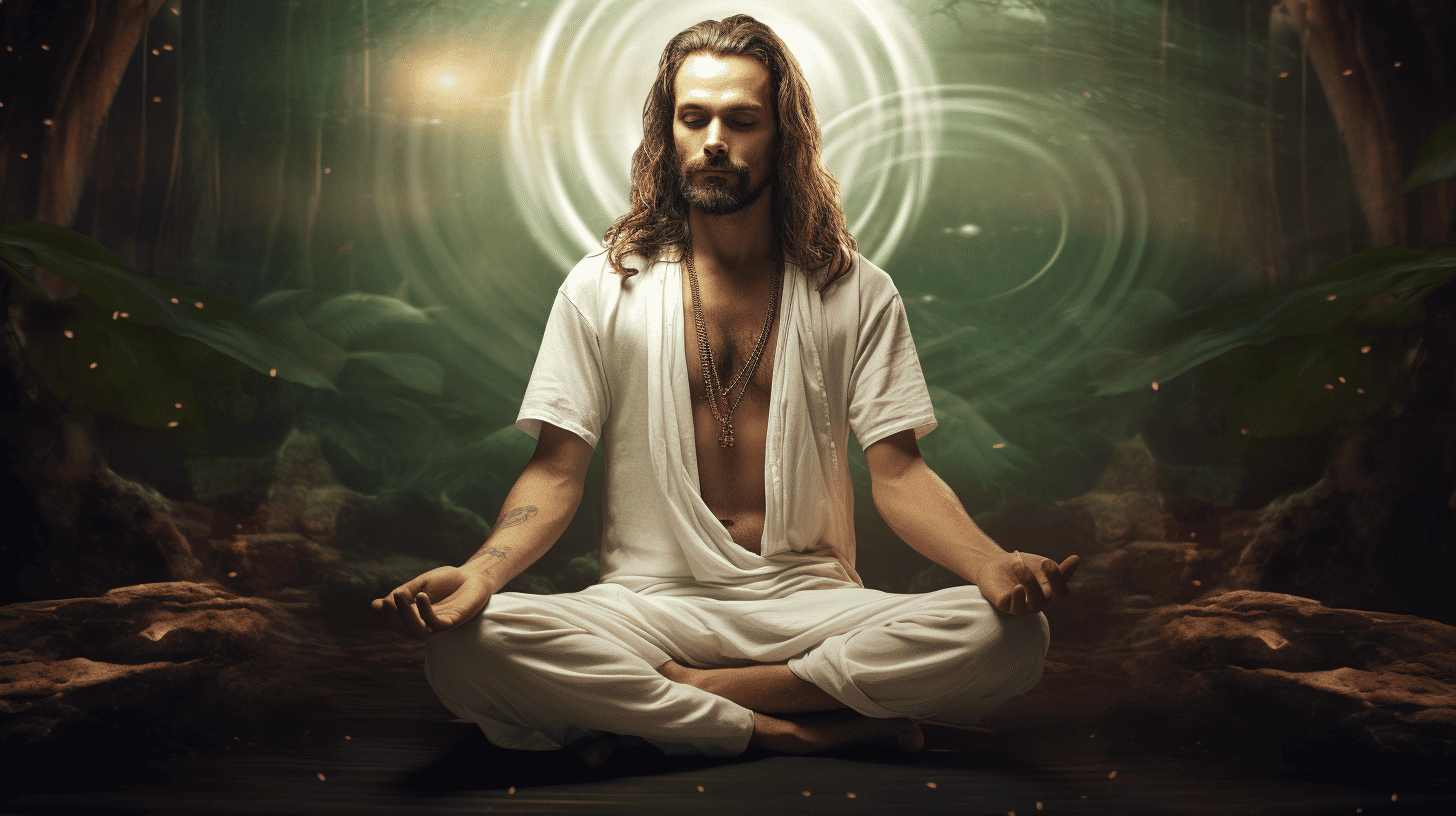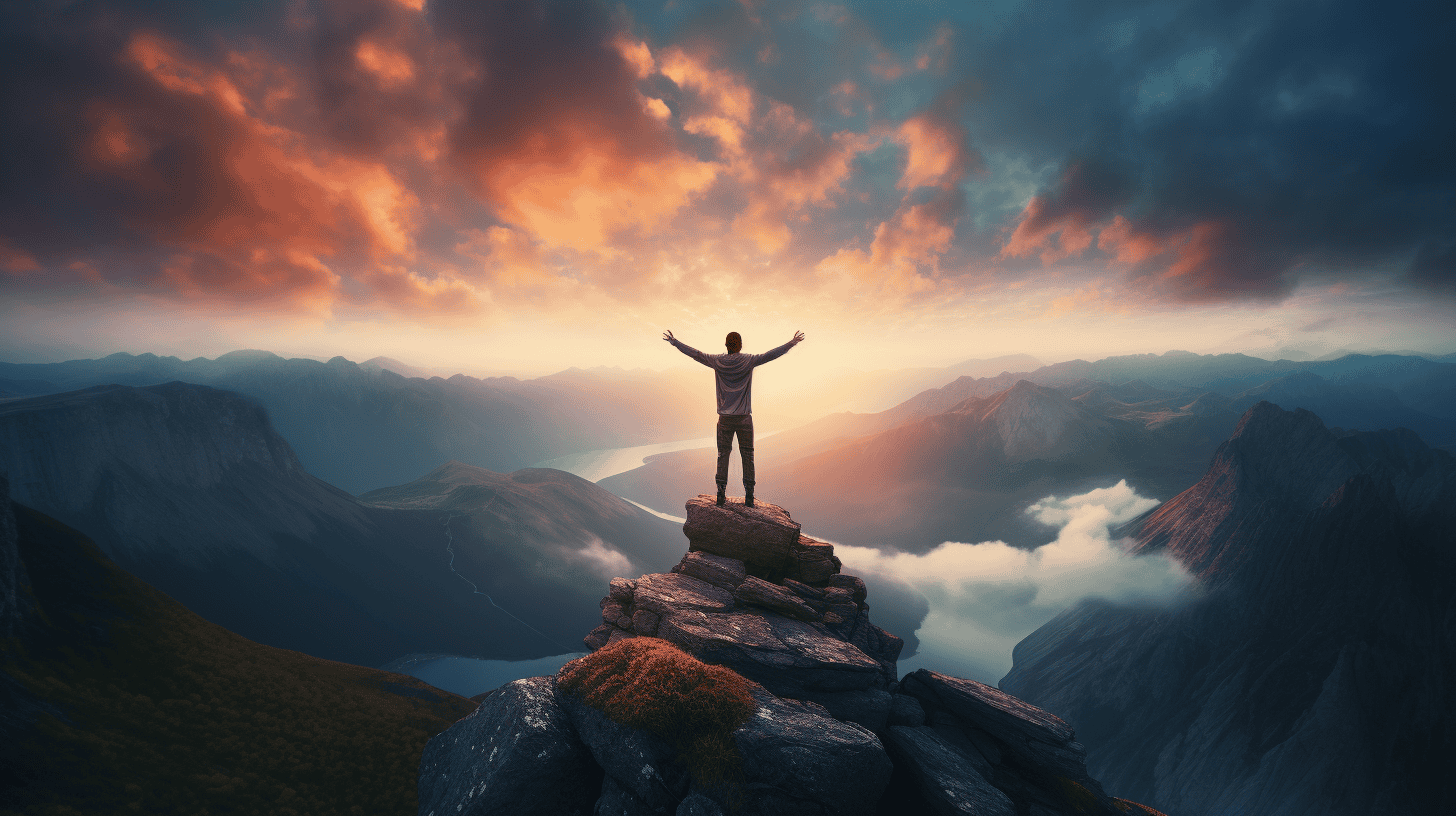As I stepped barefoot onto the yoga mat for my first ever Kundalini class, I wasn’t sure what to expect. I had heard amazing things about the powerful energy awakening and transformative potential of this mystical practice. My inner curiosity was piqued, but I’ll admit I also felt some nervous apprehension about diving into something so new and intense.
However, over the course of that one-hour class – filled with unique breathing techniques, dynamic movements, chanting, and meditation – I was amazed at how wonderful I felt afterwards. I could already sense there was something very special about Kundalini and I couldn’t wait to keep practicing and deepening my discovery.
In this comprehensive Kundalini meditation for beginners guide, I’ll share everything you need to know to get started on your own Kundalini journey. You’ll learn what Kundalini energy is, how it works, key poses and practices to awaken it safely, setting up your meditation space, working with chakras and mantras, and much more.
So let’s dive right into the yoga of awareness and higher consciousness!
Key Takeaways:
- Kundalini combines yoga, meditation, breathing, and mantras to awaken dormant inner energy
- Physically and spiritually prepare body and space for practice
- Work steadily with chakras, mantras, poses over time under guidance
- Strive to achieve higher states of consciousness and enlightened wisdom
- Uniting the finite self back to infinite Creator is the ultimate goal
How to Do Kundalini Yoga and Meditation for Beginners
Kundalini combines postures, dynamic breathing techniques, mantras, hand positions, and meditation to awaken the energy at the base of your spine and draw it upward through all 7 chakras, leading to an expanded state of awareness that yogi Bhajan called “a state of infinity”.
While intense, with physical practice and spiritual devotion over time, Kundalini creates radical positive shifts in your wellbeing, consciousness, and capacity for thriving in our modern world.
“Awake, O kundalini, by meditating on Guru’s lotus feet.” – Guru Gobind Singh
Getting Started with Kundalini Meditation
To begin, ideally attend a class led by a trained teacher to ensure proper techniques and safety. But certain foundational practices can be started solo at home after some research.
Here is a simple 10 minute beginner routine:
- Find a quiet space to sit comfortably with spine straight.
- Bring palms together at chest in prayer pose with fingers pointing up and thumbs pressing into the sternum to activate the heart center. Eyes closed.
- Inhale deeply through the nose down to the navel and exhale powerfully out through the mouth.
- Repeat breath steadily with focus at the brow point while mentally chanting “Sat Nam” on the exhales, meaning “Truth is my essence.”
- Practice for 3-11 minutes then inhale deeply, hold briefly, and exhale fully to complete.
- Take a minute and just observe how your body and mind feel before going about your day.
Repeat this daily and add other techniques over time as desired to continue awakening energy and achieving a meditative state of higher consciousness.
Lisa Beachy advises establishing a regular yoga and meditation routine first, as Kundalini can be very powerful for beginners. Visit Lisa Beachy’s Guide
Tips for Your First Kundalini Yoga Class
If attending an in-person class, read these tips to maximize your experience:
- Wear loose, comfortable clothing
- Arrive 10-15 minutes early
- Let the instructor know it’s your first class
- Position yourself where you can easily see
- Keep an open mind and heart
- Stay for the full session if you can
- Introduce yourself to others before or after
- Remember to take it at your own pace
And enjoy! The Kundalini community is welcoming for all levels. Here is a chakra table which shows location and representation of each chakra:
| Chakra | Location | Representation |
|---|---|---|
| Root | Base of spine | Security, survival |
| Sacral | Lower abdomen | Creativity, sexuality |
| Solar plexus | Upper abdomen | Confidence, self-esteem |
| Heart | Center chest | Love, relationships |
| Throat | Throat | Communication, expression |
| Third eye | Forehead | Intuition, imagination |
| Crown | Top of head | Spirituality, higher consciousness |
What is Kundalini Energy and How to Awaken It
Kundalini refers to the dormant “coiled snake” energy that lies at the base of every human’s spine. This feminine Shakti life force energy, when awakened, rises up through the 7 chakras and facilitates an expanded state of spiritual awareness and personal power.
But why is it coiled like a snake? Well, when dormant, the residual energy piles up into 3 and 1⁄2 coils along the sacrum to store power for future use.
The goal through Kundalini yoga and meditation is to channel prana and unlock this immense inner potential of Shakti Kundalini, bringing harmony to all your bodily systems and expanded consciousness capacity.
Kundalini 101: An Introduction for Beginners
Kundalini combines:
- Breathwork: Specialized pranayama breathing patterns
- Mudras: Hand gestures and positions
- Bandhas: Muscular locks and contractions
- Mantras: Chanting of sacred syllables
- Asanas: Yoga poses and postures
- Relaxation: Deep stillness and meditation
Practicing these interwoven elements channels prana (vital life-force energy) to awaken Kundalini Shakti from the Mooladhara root chakra up through all chakras into the Sahasrara crown.
This experience of rising Shakti is intensely rejuvenating with the ultimate destination being an enduring state of higher God consciousness.
How to Prepare Your Body for Kundalini Yoga
To ready your system for energy awakening through Kundalini, here are key tips:
Setting Up Your Kundalini Meditation Space
Choose a small sacred space in your home and fill it with items that uplift and inspire you spiritually:
- Comfortable cushion for floor seating
- Altars, imagery, artwork, textiles
- Candles, incense, plants, flowers
- Yoga mat, blocks, straps if needed
This personal spot will anchor your daily practice as you awaken Kundalini and journey inward. Keep it simple, clean, and energetically pristine.
Understanding the 7 Chakras in Kundalini Yoga

Central to Kundalini are the 7 chakras running along the spine from root to crown. Each has unique properties and Shadow/Light elements requiring balance.
As Kundalini Shakti rises through these wheels of energy, clearing any blocks along the way, every chakra becomes aligned and optimized to elevate body, mind and soul to the highest state of consciousness and empowerment.
The key is continual practice because it’s through daily spiritual “work” that progress is made chakra by chakra to reach new depths of inner joy, self-realization and our full potential in this world.
Incorporating Mantras into Your Practice
Beyond meaning, mantras in Kundalini create a vibrational effect(in the body to stimulate energy flow and awaken inner aspects. Chanting these ancient seed syllables passed down through teaching lineages can activate or balance specific chakras/qualities/areas of life.
Some of the most common include:
- ONG NAMO GURU DEV NAMO – “I bow to the subtle divine wisdom, the divine teacher within.”
- SA TA NA MA – Represents the cycle of creation moving from infinity, death to rebirth, and finally truth.
- RA MA DHA SA – Activates and balances the first four chakras.
- HARI OM TAT SAT – “God’s creative power is infinite.”
Experiment with different mantras during seated meditation by silently repeating them with eyes closed and focused on the sound, meaning and sensation created. Notice shifts and find your resonance.
Safely Awakening Kundalini Energy
As miraculous and primal as Kundalini Shakti is, the process of unleashing and guiding its upward flow demands care, patience, practice and grace.
Done recklessly or without proper understanding, there can be energy imbalances, over-activity of chakras and nervous system, or very challenging psychological states. This is often called “Kundalini Syndrome”.
So, having an experienced teacher to guide your awakening through the many stages and facets is strongly advised. Take things slowly and gently nurture progress step-by-step. Consistent daily practice is key over years…not days or weeks. Awakening is a slow transformative unfoldment over time.
The ultimate destination – achieving higher states of unitary consciousness and fast access to elevated wisdom – makes the gradual journey supremely worthwhile if done with care and right intention!
Conclusion on Kundalini Meditation for Beginners
While intense at times, embracing these ancient Kundalini tools for energy awakening, spiritual healing and higher consciousness can profoundly deepen your sense of purpose, inner peace, empathy for all beings, and passion for living your highest truth.
As Yogi Bhajan so beautifully stated:
“Kundalini Yoga is the science to unite the finite with Infinity…”
I hope this comprehensive beginner’s guide has provided a helpful broad overview so you can now delve more fully into your own Kundalini discovery process! Take it step-by-step and most importantly, have fun with it!
FAQ on Benefits of Kundalini Meditation
Q: How can I start my Kundalini yoga practice as a beginner?
A: To start your Kundalini yoga practice, begin with an introduction to Kundalini yoga. Learn the basics of kriyas and specific postures, how to properly inhale and exhale, and understanding the spiritual aspect of the practice. Sit in meditation with an intention of awakening your divine energy or “coiled snake” at the base of your spine. Remember to take things slow and be patient with your practice.
Q: What is the purpose of kriya in the Kundalini yoga practice?
A: Kriya is a crucial part of Kundalini yoga practice. They are specific sets of exercises that generate energy, and the practice of kriya is aimed at awakening the divine kundalini energy within us. A kriya for balancing the aura, for example, enhances the vibrational energy around the body, creating a protective field.
Q: What should I expect to feel when I practice Kundalini meditation?
A: Each individual’s experience is unique when they practice Kundalini meditation. However, it’s common to feel a clear opening of the third eye, increased vitality, and a sense of relaxation. You might also experience an awakening of consciousness, as Kundalini is about tapping into your spiritual potential.
Q: Can practicing Kundalini yoga clear my mind?
A: Yes, Kundalini yoga practice is known for its calming effect on the mind. Through kriya and deep breathing exercises like the breath of fire, you clear your mind of unwanted thoughts. It enhances your ability to focus and allows you to access a mindful state, particularly beneficial for reducing anxiety.
Q: Why is the “coiled snake” a known symbol for Kundalini?
A: Kundalini, which means “coiled” in Sanskrit, is often visualized as a dormant “coiled snake” located at the base of our spine. This coiled snake represents untapped potential spiritual energy within us. Through the practice of Kundalini, this energy is awakened and ascends up the spine, promoting spiritual awakening and enlightenment.
Q: How will Kundalini yoga practice potentially benefit me?
A: The potential benefits of a Kundalini yoga practice are numerous. They range from enhancing vitality, boosting mood, reducing anxiety, improving focus and clarity, to spiritual awakening and expansion of consciousness. Some even claim it may aid in managing conditions such as generalized anxiety disorder.
Q: Can Kundalini meditation and yoga practice affect my physical health?
A: Yes, the yoga practice of Kundalini can positively affect your physical health. Kriyas and postures improve flexibility and strength. Breathwork like the breath of fire can boost respiratory function. Additionally, the practice can improve digestion by stimulating the navel point and increase overall vitality.
Q: How is the breath of fire incorporated in Kundalini yoga practice?
A: The breath of fire is a critical part of Kundalini yoga practice. This deep breathing technique requires you to inhale and exhale rapidly through your nose. It’s pivotal in stimulating the navel point and awakening the “coiled snake” energy at the base of the spine.
Q: What is the relation between Kundalini and the “third eye”?
A: In Kundalini yoga practice, the “third eye” or “ajna” chakra is considered the command center of our spiritual energy. As this energy rises from the base of the spine to the third eye during meditation, it leads to an awakening of consciousness and heightened intuition.
Q: Who popularized Kundalini yoga practice in the West?
A: Kundalini Yoga as it is known today was brought to the western world by Yogi Bhajan. Yogi Bhajan began teaching this form of yoga in the late 1960s, and his teachings have since inspired thousands across the globe to start a Kundalini yoga practice.





Leave a Reply